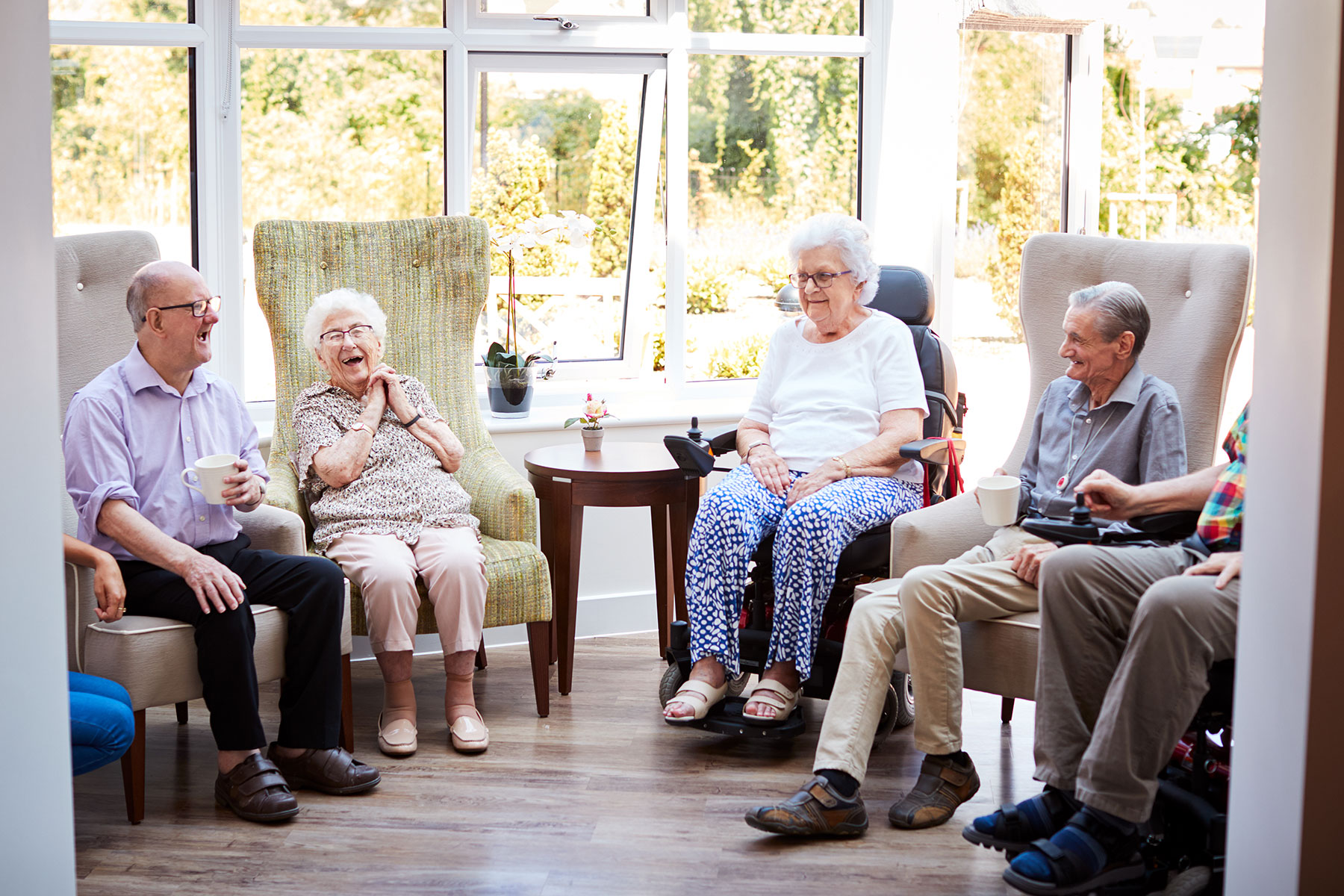Staged Memory Care
January 19, 2023

Benefits to a staged memory care setting vs. a non-staged setting
Memory Care Assisted Living environments came into the senior living market of Minnesota in the 90’s and have changed dramatically over these past few decades. Today, seniors with dementia and their loved ones are presented with a wide array of services and memory care models to choose from. For over 20 years, I’ve been privileged to offer guidance to families as they navigate the process of choosing memory care and I’ve experienced firsthand how memory care has evolved. Not all care settings are equal, even if terminology, labels, or staff titles are the same. With this article, I hope to offer clarity to a process that can be confusing and stressful for individuals, families and caregivers who are evaluating and selecting memory care.
Two Types of Memory Care
Memory loss is not a static diagnosis, but instead a condition that progresses over time. In a traditional memory care setting, a group of individuals with memory loss will interact daily with others who may be at any point along the spectrum of progression, and their care staff and environment must support this entire set of needs. In a staged model of memory care, resident placement offers specified units, buildings, or floors which are shared with other residents experiencing similar levels of dementia and needs. Staged environments support residents with care teams, environmental designs, and activities targeted to the precise level memory loss progression.
Emerald Crest Early Years: Recognizing Challenges with Non-Staged Memory Care
At Emerald Crest, we offer three levels of dementia care, but we didn’t start out that way. When we opened our doors in 1998, all levels of dementia were mixed, a standard practice at that time. Our campus is set up with multiple houses that have 12-15 units each. At first, houses would have up to 15 residents that ranged from early to late stage. Over time, we noticed residents’ range of function grow wider. We were seeing more advanced individuals as well as earlier stage individuals who shared the necessity for a memory care setting due to safety, but other needs could be vastly different.
Struggles with Resident Engagement
Engaging residents in a non-staged model is an immediate challenge. As an example, finding and leading successful activities was a struggle with multiple levels of dementia being experienced in one group. Activities tended to be a one-size-fits-all approach, which did not serve all residents equally, because of the vastly different levels of cognition and function unique to each individual. Residents could not always follow the activities presented: an activity could be too simplified for higher functioning individuals, or difficult and overstimulating for others.
Increased Behaviors and Clinical Needs
Behavior prevention and management was also challenging, as we often noticed more behaviors with a non-staged model of dementia care. With the inability to meet all the residents’ needs with activities, we would see an increase in:
- Isolating or refusal to attend activities
- Wandering or exit seeking
- Frustration and agitation,
- Boredom or excessive daytime sleep, resulting in wakefulness at night
With an increase in these behaviors, we would often see increased clinical or medical needs as well, such as:
- Use of psychotropic or other anti-anxiety/anti-depressant medications
- Falls or injuries
Care and Training Challenges
As our resident’s range of function grew wider, it became more apparent that care teams were similarly challenged. To be successful in daily care, teams and staff would need to be educated, and function fluently in multiple levels of memory care needs and approaches. Both in individual and group interactions, as well as team tasks, staff would need to be coordinated to meet each individual resident’s needs. Consider a classroom with a mix of kindergarten through fifth graders all learning at once from the same teacher: it would be a momentous challenge to match instructions, lessons, and results equally for each student. It would not be realistic to have the expectation of such a teacher to have in-depth knowledge and equal achievement with everyone present. The ultimate success and happiness of each individual would be a substantial accomplishment – this is the level of challenge that is presented for a caregiver in a non-staged memory care unit.
The care and needs of an early-stage memory care resident are vastly different than approaches used for middle or late-stage residents. Matching staff training and team capability to meet all needs in one space became overwhelming in our early years in memory care, and presented lower potential for success as a result. This was the core lesson in the evolution of memory care toward a staged model.

The Emerald Crest Staged Model Today
In 2014, we had enough observation and identification of specific challenges in the non-staged model of memory care to recognize the opportunity for a new strategy that better served each individual resident. This evolution prompted our current staged memory care model: the three levels we have today in our campus houses.
The Vine House: Stage 1 for early/early middle stage dementia
The Spring House: Stage 2 for middle/late middle stage dementia
The Marigold House: Stage 3 for late/end stage dementia
Our goal with these distinctive stages is to encourage the skills and abilities in our residents foremost, and training our teams and care staff in support of this goal. Staff are educated and develop the expertise to supplement care in a more targeted way, enhancing daily life of residents. This guiding vision allows for the highest level of interaction and quality of life for each of our residents, no matter the stage of memory loss they currently experience.
View complete Emerald Care Model and stage descriptions
Results and benefits of a staged model of memory care: The three different stages of our houses at Emerald Crest provide an environment designed to meet the needs of the residents in that stage or house. Scheduling, activities, communication techniques, and care approaches focus on the resident’s current stage of dementia and promote abilities. Great success is experienced by residents and staff with this more focused memory care model.
Successful Activities and Engagement
By staging the houses, the activities provided to residents have meaning and relevance, and focus on maximizing individual abilities. Residents are socializing with others that are at a similar level of function to their own, resulting in increased participation in group activities and sense of comfort and belonging when around others.
In higher functioning houses, residents have conversations with each other for increased socialization. In an environment with lower functioning, there tends to be more acceptance of other residents for common behaviors that at times can be frustrating for those in a higher functioning house, such as repetitive questions, wandering, or disorientation. Residents can continue to experience an appropriate level of social interaction that supports comfort in their environment.
Reducing Behaviors
Each staged house can focus on the common needs and patterns identified at each level of dementia, designing daily life and interaction in a way that helps limit or prevent behaviors. For example, wandering is a very common pattern we see in middle to late-stage dementia. Therefore, in those houses the activities, communication techniques, care approaches, and environment are designed to help limit or safeguard against that behavior.
With staged houses in place, we see a reduction of psychotropic medication use for depression and anxiety. With more participation and success in activity programs, agitation and frustration are decreased. We see residents sleep better at night because they have been more engaged and awake throughout the day. With better sleep and more complete rest, as well as more satisfaction in daily activities, physical safety is increased and fewer falls or injuries experienced.
Care Staff Difference
The benefits of staging in dementia care for the staff are many, but all result in better care for residents. Learning the care and communication approaches for a specific stage of dementia becomes more fluent when focused to a specific set of needs, and expertise develops more quickly. Successful interactions increase, with satisfaction for both residents and caregivers. Proven strategies are more completely integrated in houses at each stage. Care staff work in the same house and become specialists of that specific level or stage and thus can provide the best quality of care.
The staged dementia model makes it easier to engage the residents in everyday activities and a lifestyle that are most appropriate to their current ability. This improvement in resident engagement promotes the circle of Engagement > Behavior Reduction > Staff Care Focus, as participation in activities increases, and over time consistently improves daily life. Staff members experience confidence and residents a calmer environment ongoing, benefiting everyone.

Aging in Place in a Staged Model
We all know that an environment change for someone living with dementia can be upsetting. In addition, we recognize that an individual with dementia does not remain in one stage. In a staged model of memory care, it is very likely a resident will need to transition into the next stage as their functional level changes. At Emerald Crest, our model anticipates transitions, and we are well-prepared.
How do our families and residents handle the transition or move into a different stage/house? At Emerald Crest the need to transition to the next stage usually doesn’t happen overnight. Usually, it is determined through many assessments and conversations including the care team.
Jeanne Anderson, RN and Director of Health Services at Emerald Crest of Shakopee says, “At Emerald Crest we provide ongoing education on the different stages from day one and keep them updated on changes regularly. We also have a support group where they can talk to other families who have experienced a change in stages or move. Our team keeps the families updated on changes and the benefits of moving their loved one when the time is right for the resident to transition. We look at the larger picture of the environment and that resident’s needs, and their journey, and how we can make the transition go smoothly for that person.”
At Emerald Crest every house floor plan, layout and décor is the same. This helps to make the transition between stages and houses easier and more comforting for the resident. We also take care of the moving of furniture to the new house, so families can focus on their loved one during a transition. Care teams work hard on organizing a supportive plan to ease the process of moving and make a transition to a new house stress-free.
The Decision to Select Staged Memory Care
We understand, through our own evolution and experience, that evaluating and selecting memory care can be a significant process for any caregiver or family member. Our goal is to bring our expertise in service to those with memory loss and through the staged model of memory care support the best possible quality of life and meaningful activity for each of our memory care residents. If you are researching and choosing memory care, considering the current and future needs of a loved one is a vital part of the selection process.
Our teams are ready for the specific needs of all memory care stages and we look forward to talking with you if you have questions.
At Emerald Crest, we offer a deep knowledge of memory care in a specialized assisted living setting for seniors with Alzheimer’s and dementia-related conditions. We encourage you to contact us directly with any questions or request a tour. For tours and general information, please contact Elizabeth Wendel at 952-908-2215.
Emerald Crest by Cassia provides memory care in a unique environment, specifically designed to support those with cognitive issues. Utilizing this exceptional model of care, individuals with dementia, Alzheimer’s and related conditions can flourish in positive relationships and participation in meaningful activities. Memory care is offered in the Minneapolis – Saint Paul area with communities in four convenient locations: Shakopee, Burnsville, Minnetonka, MN.

